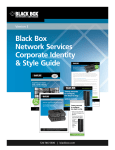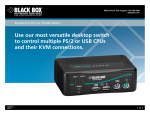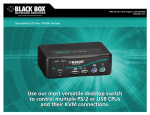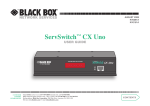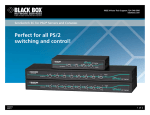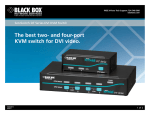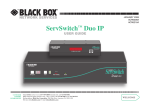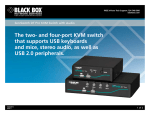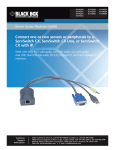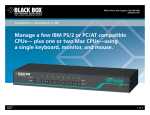Download Black Box KV7021A User's Manual
Transcript
OCTOBER 2007 KV7020A KV7021A 2- and 4-Port ServSwitch DT Pro II CUSTOMER SUPPORT INFORMATION Order toll-free in the U.S.: Call 877-877-BBOX (outside U.S. call 724-746-5500) FREE technical support 24 hours a day, 7 days a week: Call 724-746-5500 or fax 724-746-0746 Mailing address: Black Box Corporation, 1000 Park Drive, Lawrence, PA 15055-1018 Web site: www.blackbox.com • E-mail: [email protected] FCC AND IC RFI STATEMENTS FEDERAL COMMUNICATIONS COMMISSION and INDUSTRY CANADA RADIO FREQUENCY INTERFERENCE STATEMENTS Class B Digital Device. This equipment has been tested and found to comply with the limits for a Class B computing device pursuant to Part 15 of the FCC Rules. These limits are designed to provide reasonable protection against harmful interference in a residential installation. However, there is no guarantee that interference will not occur in a particular installation. This equipment generates, uses, and can radiate radio frequency energy, and, if not installed and used in accordance with the instructions, may cause harmful interference to radio communications. If this equipment does cause harmful interference to radio or telephone reception, which can be determined by turning the equipment off and on, the user is encouraged to try to correct the interference by one of the following measures: • Reorient or relocate the receiving antenna. • Increase the separation between the equipment and receiver. • Connect the equipment into an outlet on a circuit different from that to which the receiver is connected. • Consult an experienced radio/TV technician for help. CAUTION Changes or modifications not expressly approved by the party responsible for compliance could void the user’s authority to operate the equipment. To meet FCC requirements, shielded cables and power cords are required to connect this device to a personal computer or other Class B certified device. This digital apparatus does not exceed the Class B limits for radio noise emission from digital apparatus set out in the Radio Interference Regulation of Industry Canada. Le présent appareil numérique n’émet pas de bruits radioélectriques dépassant les limites applicables aux appareils numériques de classe B prescrites dans le Règlement sur le brouillage radioélectrique publié par Industrie Canada. 1 2- AND 4-PORT SERVSWITCH DT PRO II NORMAS OFICIALES MEXICANAS (NOM) ELECTRICAL SAFETY STATEMENT INSTRUCCIONES DE SEGURIDAD 1. Todas las instrucciones de seguridad y operación deberán ser leídas antes de que el aparato eléctrico sea operado. 2. Las instrucciones de seguridad y operación deberán ser guardadas para referencia futura. 3. Todas las advertencias en el aparato eléctrico y en sus instrucciones de operación deben ser respetadas. 4. Todas las instrucciones de operación y uso deben ser seguidas. 5. El aparato eléctrico no deberá ser usado cerca del agua—por ejemplo, cerca de la tina de baño, lavabo, sótano mojado o cerca de una alberca, etc.. 6. El aparato eléctrico debe ser usado únicamente con carritos o pedestales que sean recomendados por el fabricante. 7. El aparato eléctrico debe ser montado a la pared o al techo sólo como sea recomendado por el fabricante. 8. Servicio—El usuario no debe intentar dar servicio al equipo eléctrico más allá a lo descrito en las instrucciones de operación. Todo otro servicio deberá ser referido a personal de servicio calificado. 9. El aparato eléctrico debe ser situado de tal manera que su posición no interfiera su uso. La colocación del aparato eléctrico sobre una cama, sofá, alfombra o superficie similar puede bloquea la ventilación, no se debe colocar en libreros o gabinetes que impidan el flujo de aire por los orificios de ventilación. 10. El equipo eléctrico deber ser situado fuera del alcance de fuentes de calor como radiadores, registros de calor, estufas u otros aparatos (incluyendo amplificadores) que producen calor. 11. El aparato eléctrico deberá ser connectado a una fuente de poder sólo del tipo descrito en el instructivo de operación, o como se indique en el aparato. 2 NOM STATEMENT 12. Precaución debe ser tomada de tal manera que la tierra fisica y la polarización del equipo no sea eliminada. 13. Los cables de la fuente de poder deben ser guiados de tal manera que no sean pisados ni pellizcados por objetos colocados sobre o contra ellos, poniendo particular atención a los contactos y receptáculos donde salen del aparato. 14. El equipo eléctrico debe ser limpiado únicamente de acuerdo a las recomendaciones del fabricante. 15. En caso de existir, una antena externa deberá ser localizada lejos de las lineas de energia. 16. El cable de corriente deberá ser desconectado del cuando el equipo no sea usado por un largo periodo de tiempo. 17. Cuidado debe ser tomado de tal manera que objectos liquidos no sean derramados sobre la cubierta u orificios de ventilación. 18. Servicio por personal calificado deberá ser provisto cuando: A: El cable de poder o el contacto ha sido dañado; u B: Objectos han caído o líquido ha sido derramado dentro del aparato; o C: El aparato ha sido expuesto a la lluvia; o D: El aparato parece no operar normalmente o muestra un cambio en su desempeño; o E: El aparato ha sido tirado o su cubierta ha sido dañada. 3 2- AND 4-PORT SERVSWITCH DT PRO II TRADEMARKS USED IN THIS MANUAL iMac, Mac, Macintosh, and Mac OS are registered trademarks of Apple Computer, Inc. BLACK BOX and the Double Diamond logo are registered trademarks, and ServSwitch is a trademark of BB Technologies, Inc. PS/2 is a registered trademark of International Business Machines Corporation. Linux is a registered trademark of Linus Torvalds. IntelliMouse, Microsoft, Windows, and Windows NT are either registered trademarks or trademarks of Microsoft Corporation in the United States and/or other countries. NetWare and Novell are registered trademarks of Novell, Inc. Any other trademarks mentioned in this manual are acknowledged to be the property of the trademark owners. 4 CONTENTS Contents Chapter Page 1. Specifications . . . . . . . . . . . . . . . . . . . . . . . . . . . . . . . . . . . . . . . . . . . . . . . . . . . . 6 2. Overview. . . . . . . . . . . . . . . . . . . . . . . . . . . . . . . . . . . . . . . . . . . . . . . . . . . . . . . . 8 2.1 Introduction . . . . . . . . . . . . . . . . . . . . . . . . . . . . . . . . . . . . . . . . . . . . . . . . . 8 2.2 Components . . . . . . . . . . . . . . . . . . . . . . . . . . . . . . . . . . . . . . . . . . . . . . . . . 9 2.2.1 Front Panel . . . . . . . . . . . . . . . . . . . . . . . . . . . . . . . . . . . . . . . . . . . . . 9 2.2.2 Rear Panel . . . . . . . . . . . . . . . . . . . . . . . . . . . . . . . . . . . . . . . . . . . . . 10 2.3 What’s Included . . . . . . . . . . . . . . . . . . . . . . . . . . . . . . . . . . . . . . . . . . . . . 11 2.4 What You’ll Need to Supply . . . . . . . . . . . . . . . . . . . . . . . . . . . . . . . . . . . 11 3. Installation . . . . . . . . . . . . . . . . . . . . . . . . . . . . . . . . . . . . . . . . . . . . . . . . . . . . . 12 3.1 ServSwitch Placement . . . . . . . . . . . . . . . . . . . . . . . . . . . . . . . . . . . . . . . . 12 3.2 Hardware Installation . . . . . . . . . . . . . . . . . . . . . . . . . . . . . . . . . . . . . . . . 12 3.2.1 Connecting the Console. . . . . . . . . . . . . . . . . . . . . . . . . . . . . . . . . . 12 3.2.2 Powering On the ServSwitch . . . . . . . . . . . . . . . . . . . . . . . . . . . . . . 14 3.2.3 Connecting the Computers . . . . . . . . . . . . . . . . . . . . . . . . . . . . . . . 15 3.2.4 Connecting the USB Peripherals. . . . . . . . . . . . . . . . . . . . . . . . . . . 16 4. Operation . . . . . . . . . . . . . . . . . . . . . . . . . . . . . . . . . . . . . . . . . . . . . . . . . . . . . . 17 4.1 Powering Up the System . . . . . . . . . . . . . . . . . . . . . . . . . . . . . . . . . . . . . . 17 4.2 Selecting Computers Using Front-Panel Buttons . . . . . . . . . . . . . . . . . . 17 4.3 Selecting Computers Using Keyboard Hotkey Commands . . . . . . . . . . 17 Appendix. Troubleshooting. . . . . . . . . . . . . . . . . . . . . . . . . . . . . . . . . . . . . . . . . . . 21 A.1 Calling Black Box . . . . . . . . . . . . . . . . . . . . . . . . . . . . . . . . . . . . . . . . . . . . 21 A.2 Shipping and Packaging . . . . . . . . . . . . . . . . . . . . . . . . . . . . . . . . . . . . . . 21 5 2- AND 4-PORT SERVSWITCH DT PRO II 1. Specifications Resolution: 2048 x 1536 Supported Operating Systems: Windows® 98/Me/2000/XP and Windows NT®, Linux®, NetWare®, Mac OS® Hotkeys: Yes User Controls: KV7020A: (2) port selection buttons; KV7021A: (4) port selection buttons Connectors: KV7020A: Computer end: PS/2® keyboard, PS/2 mouse, VGA Video: (2) HD15 female, USB keyboard, mouse, and peripherals: (2) USB Type B female, Microphones/speakers: (4) 3.5-mm jacks; Console end: Keyboard: (1) 6-pin mini-DIN female or (1) USB Type A female, Mouse: (1) 6-pin mini-DIN female or (1) USB Type A female, Monitor: (1) HD15 female, USB peripherals: (2) USB Type A female, Microphone/speaker: (2) 3.5-mm jacks, Power: (1) barrel connector; KV7021A: Computer end: PS/2 keyboard, PS/2 mouse, and VGA video: (4) HD15 female, USB keyboard, mouse, and peripherals: (4) USB Type B female, Microphones/speakers: (8) 3.5-mm jacks; Console end: Keyboard: (1) 6-pin mini-DIN female or (1) USB Type A female, Mouse: (1) 6-pin mini-DIN female or (1) USB Type A female, Monitor: (1) HD15 female, USB peripherals: (2) USB Type A female, Microphone/speaker: (2) 3.5-mm jacks, Power: (1) barrel connector Indicators: KV7020A: (2) Port LEDs, (2) Hub LEDs; KV7021A: (4) Port LEDs, (4) Hub LEDs Temperature Tolerance: Operating: 32 to 104°F (0 to 40°C); Storage: -4 to +140°F (-20 to +60°C) Relative Humidity: Up to 80%, noncondensing 6 CHAPTER 1: Specifications Power: 9-VDC power supply Size: KV7020A: 1.8"H x 5.4"W x 3.5"D (4.5 x 13.8 x 9.1 cm); KV7021A: 1.8"H x 8.7"W x 4.1"D (4.5 x 22 x 10.5 cm) Weight: KV7020A: 1.8 lb. (0.8 kg); KV7021A: 2 lb. (0.9 kg) 7 2- AND 4-PORT SERVSWITCH DT PRO II 2. Overview 2.1 Introduction The 2- or 4-Port ServSwitch™ DT Pro II KVM Switch is the most comprehensive desktop switch to date. It’s flexible: Use it to connect a PS/2 keyboard, video, and mouse to PS/2 CPUs, USB KVM to PS/2 CPUs, PS/2 KVM to USB CPUs, or USB KVM to USB CPUs. Supported mice include Microsoft® IntelliMouse® and other mice, and the ServSwitch unit’s USB ports comply with USB 2.0 requirements. Plus, you can connect audio and USB 2.0 peripherals to the KVM switch. Using a hotkey command sequence (see Section 4.3), you can asynchronously switch the KVM control and the USB devices. And the ServSwitch works with common operating systems, including Windows 98/Me/2000/XP, Windows NT®, Linux, Novell® NetWare, and Mac OS. Setup is fast and simple, and there’s no software to configure. Its small desktop footprint is ideal for on or under your desktop. Use either front-panel buttons on the ServSwitch or hotkeys (which are key sequences on your keyboard) to select ports or start AutoScan. The front-panel buttons include integral LEDs. The LED will light with the corresponding active port when manually switching between the computers. The ServSwitch beeps to confirm that it’s in hotkey mode. The AutoScan function enables you to automatically scan and monitor all computers, one by one, that are connected to the ServSwitch. 8 CHAPTER 2: Overview 2.2 Components 2.2.1 FRONT PANEL Figure 2-1 shows the 2- and 4-Port ServSwitch front views. Table 2-1 describes the components numbered in the illustration. ❷ ❷ ❸ ❸ ❹ ❶ ❹ ❶ Figure 2-1. The ServSwitch front-panel views. Table 2-1. Front-panel components. Component Description ❶ 6-pin mini-DIN connectors PS/2 keyboard and mouse ports. ❷ Direct-access port buttons Press to select a computer. ❸ Port LEDs and Hub LEDs Port LEDs located below the port buttons light when the connected computer is selected. Hub LEDs light to indicate which port has the hub control. ❹ USB ports USB keyboard and mouse ports. 9 2- AND 4-PORT SERVSWITCH DT PRO II 2.2.2 REAR PANEL Figure 2-2 shows the 2- and 4-Port ServSwitch rear views. Table 2-2 describes the components numbered in the illustration. ❻ ❺ ❿ ❾ ❺ ❾ ❼ ❽ ❼ ❽ ❿ ❼ ❽ ❻ ❼ ❽ ❼ ❽ ❼ ❽ Figure 2-2. The ServSwitch back-panel views. Table 2-2. Rear-panel components. Component Description ❺ Console VGA port Attaches to the user monitor. ❻ Computer VGA ports Connect to a computer’s video cards and keyboard and mouse when used with PS/2 computers. ❼ Computer USB 1.1 keyboard/mouse port Link to a computer’s USB 1.1 keyboard and mouse ports. ❽ Computer speaker/ microphone ports Attach the computer’s speaker and microphone ports. (Two leftmost audio ports are for console.) ❾ Power connector Connects to a 9-VDC power supply (required). ❿ USB hub ports Connects to USB hub or peripherals. 10 CHAPTER 2: Overview 2.3 What’s Included The KV7020A or KV7021A package should contain the following items. If anything is missing or damaged, please contact Black Box. • (1) 2- or 4-Port ServSwitch DT Pro II KVM Switch • (1) Power supply for U.S., Europe, Great Britain, and Australia • This user’s manual 2.4 What You’ll Need to Supply • ServSwitch DT Pro II Cable (EHN7002021-0006, -0009, -0015): These cables connect to PCs that have PS/2 or USB and VGA connectors. The cables are available in 6-, 9-, and 15-foot (1.8-, 2.7-, and 4.5-m) versions. However, the USB 2.0 specification only allows a valid USB connection within a 6-foot (1.8-m) cabling distance. 11 2- AND 4-PORT SERVSWITCH DT PRO II 3. Installation 3.1 ServSwitch Placement The 2- or 4-Port ServSwitch DT Pro II KVM Switch is small, portable, and designed to fit on a desktop. Consider the following when deciding where to place the KVM switch: • How long are the cables attached to your keyboard, mouse, and monitor? • How far away are the computers from the console? • How long are the cables you use to connect your computers to the ServSwitch? CAUTION Do not place cables near machines that create electrical noise such as fluorescent lighting, air conditioning equipment, etc. 3.2 Hardware Installation This section provides instructions for the basic hardware setup of a single ServSwitch. CAUTION Before you begin, make sure that power to all the devices that you will be connecting is turned off. To prevent damage caused by ground potential differences, make sure that all devices are properly grounded. If you don’t follow these instructions, your computers and/or the ServSwitch could be damaged. 3.2.1 CONNECTING THE CONSOLE 1. Power off all computers. 2. Connect your USB keyboard and USB mouse or PS/2 keyboard and PS/2 mouse directly to the USB or PS/2 keyboard and mouse ports (labeled with keyboard and mouse symbols) on the front of the ServSwitch. USB connections are shown in Figure 3-1. 12 CHAPTER 3: Installation 4-Port ServSwitch DT Pro KVM Switch (KV7021A) Keyboard Mouse Figure 3-1. Keyboard and mouse connections. 3. Connect the HD15 VGA male connector from your monitor to the console VGA port on the back of the ServSwitch. See Figure 3-2. Monitor 4-Port ServSwitch DT Pro KVM Switch (KV7021A) Figure 3-2. Console connections. 4. Connect the speaker and microphone connectors from your computer to the audio ports on the back of the unit. See Figure 3-3. 13 2- AND 4-PORT SERVSWITCH DT PRO II Figure 3-3. Audio connections. 3.2.2 POWERING ON THE SERVSWITCH Connect the 9-VDC power adapter’s barrel connector to the power jack on the rear of the switch. Then plug the power adapter cable into an available power outlet. See Figure 3-4. 9-VDC power adapter Figure 3-4. Power connections. 14 CHAPTER 3: Installation 3.2.3 CONNECTING THE COMPUTERS USB Installation 1. Connect the ServSwitch DT Pro II’s USB cable’s (EHN7002021-0006) USB connector to the PC1 USB port on the back of the ServSwitch. Connect the cable’s VGA connector to the ServSwitch unit’s PC1 VGA connector. See Figure 3-5. 2. Connect the cable’s male VGA and USB connectors to the corresponding connectors on the back of the computer. USB USB, VGA, and audio connectors on the computer Figure 3-5. USB computer connections. 3. Repeat steps 1 and 2 for all computers. 4. Power on your computers. Your computers’ operating systems should recognize the ServSwitch and will automatically install the USB driver if it was not already installed on your computers. NOTE On some computers, you must enable USB support on your system BIOS. Please refer to your computer manufacturer’s manual or the motherboard manual to verify that USB support is enabled. 15 2- AND 4-PORT SERVSWITCH DT PRO II 3.2.4 CONNECTING THE USB PERIPHERALS Attach up to two USB peripherals to the USB Type A connectors on the ServSwitch. See Figure 3-6. NOTE You can attach a USB keyboard and mouse, but hotkey switching will not be enabled for these connections. USB peripherals Figure 3-6. USB peripheral connections. 16 CHAPTER 4: Operation 4. Operation 4.1 Powering Up the System Once all cables have been connected and all computers have been powered on, the ServSwitch emulates mouse and keyboard signals on each port, enabling your computer to boot normally. The ServSwitch is now ready for use. 4.2 Selecting Computers Using Front-Panel Buttons You can instantly select any computer by pressing the port selector buttons on the front panel. The corresponding LED will light when the port is selected. 4.3 Selecting Computers Using Keyboard Hotkey Commands To directly switch the KVM control to any computer via the simple keyboard command sequence, press the <Left-Ctrl> key twice and the <up-arrow> or <down-arrow> keys. 1. To invoke the hotkey mode, press the <Left-Ctrl> key twice within two seconds. The switch will beep to indicate that it’s in hotkey mode. 2. Press the <up-arrow> or <down-arrow> keys to switch to the previous or next port, respectively. Table 4-1 lists the hotkey commands. 17 2- AND 4-PORT SERVSWITCH DT PRO II Table 4-1. Hotkey commands. Command Command/Description <Left-Ctrl><Left-Ctrl> x Select PC channel. Select active PC channel.(x is a top-row number key) x=1–2 or 1–4 for PC channel number <Left-Ctrl><Left-Ctrl> (Fx) Select hub port control. Select the specific PC + USB hub port control— works only if PC port/hub port control binding is enabled. Fx=F1–F2 or F1–F4 (Fx is a function key); x=1–2 or 1–4 for PC channel number <Left-Ctrl><Left-Ctrl> (Fy) Select audio + microphone channel. Select the active audio and microphone channel. (Joint-select PC/hub port control/audio and microphone, if binding is enabled.) Fy=F5–F6 or F5–F8 (Fy is a function key); y=1–2 or 1–4 for audio/ microphone channel number <Left-Ctrl><Left-Ctrl> + Z Bind PC and hub port control switching. Enable the binding of PC port and hub port control switching. (Once this feature is enabled, any PC and/or hub port control switching is bound together.) (factory default) <Left-Ctrl><Left-Ctrl> + X Unbind PC and hub port control switching. Disable the binding of PC port and hub port control switching. 18 CHAPTER 4: Operation Table 4-1 (continued). Hotkey commands. Command Command/Description <Left-Ctrl><Left-Ctrl> Q Bind PC and audio/microphone switching. Enable the binding of PC port and audio/microphone switching. (Once enabled, any PC and/or audio/microphone switching is bound together. (This is the factory default.) <Left-Ctrl><Left-Ctrl> W Unbind PC and audio/microphone switching. Disable the binding of PC port and audio/microphone switching. <Left-Ctrl><Left-Ctrl> <up-arrow> Next lower PC channel. Select the next lower PC channel. (Joint-select PC/hub port control/audio and microphone, if binding is enabled.) <Left-Ctrl><Left-Ctrl> <down-arrow> Next higher PC channel. Select the next active PC. (Joint-select PC/hub port control/audio and microphone, if binding is enabled.) <Left-Ctrl><Left-Ctrl> <backspace> Previous PC channel. Toggle between the previous channel and current channel. <Left-Ctrl><Left-Ctrl> B Beep sound on/off. Toggle on/off the beep sound for hotkey and autoscanning. <Left-Ctrl><Left-Ctrl> H + y Define hotkey preceding sequence. Select the hotkey preceding sequence among six alternative keys: y=Scroll Lock, Caps, Esc, F12, Num-Lock, Left-Ctrl. 19 2- AND 4-PORT SERVSWITCH DT PRO II Table 4-1 (continued). Hotkey commands. Command Command/Description <Left-Ctrl><Left-Ctrl> S Autoscan. Autoscan through every connected channel for quick screen browsing of each channel (scan delay=10 seconds). <Left-Ctrl><Left-Ctrl> S + z Autoscan with programmable delay time. Autoscan with a user-defined delay time within a range of 10 to 100 seconds. z=0-9 for 10, 20, 30, 40, 50, 60, 70, 80, 90, or 100 seconds Press any key on keyboard. Stop Autoscan. <Left-Ctrl><Left-Ctrl> V Show the current unit’s resident firmware number. You must open a text editor window (such as Wordpad) so that the character string can be output to the windows. NOTE After switching ports, there is a delay of up to 2 seconds before the video displays. This is normal and is because of the video signal’s refresh rate. 20 APPENDIX: Troubleshooting Appendix. Troubleshooting A.1 Calling Black Box If you determine that your 2- or 4-Port ServSwitch DT Pro II KVM Switch is malfunctioning, do not attempt to alter or repair the unit. It contains no userserviceable parts. Contact Black Box at 724-746-5500. Before you do, make a record of the history of the problem. We will be able to provide more efficient and accurate assistance if you have a complete description, including: • the nature and duration of the problem. • when the problem occurs. • the components involved in the problem. • any particular application that, when used, appears to create the problem or make it worse. A.2 Shipping and Packaging If you need to transport or ship your 2- or 4-Port ServSwitch DT Pro II KVM Switch: • Package it carefully. We recommend that you use the original container. • If you are shipping the 2- or 4-Port ServSwitch DT Pro II KVM Switch for repair, make sure you include everything that came in the original package. Before you ship, contact Black Box to get a Return Authorization (RA) number. 21 © Copyright 2007. Black Box Corporation. All rights reserved. 1000 Park Drive • Lawrence, PA 15055-1018 • 724-746-5500 • Fax 724-746-0746























